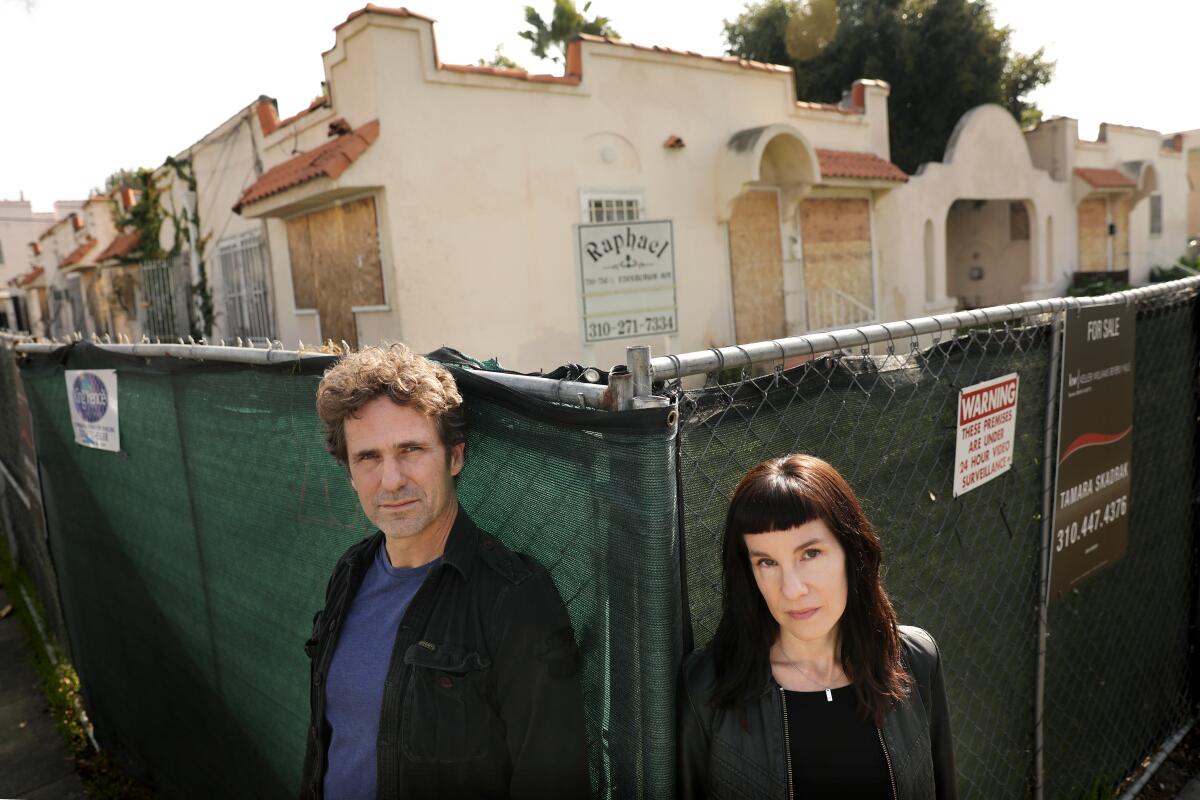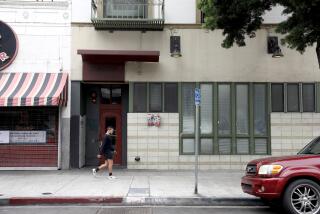Are you a fan of old L.A.’s charm? These historic bungalows need a savior with deep pockets

Wanted: A civic-minded lover of Los Angeles history who has ample financial means, isn’t afraid of a fixer-upper and is ready to act now.
A charming but worn 1923 bungalow court arranged in a U of four buildings and a garage is on the market just north of Melrose in Beverly Grove.
The Edinburgh Bungalow Court, whose communal outdoor space is entered through a distinctive arched gateway, is the kind of affordable housing that sprang up to fill a great need as Hollywood movie-making boomed and the area’s population exploded. It was built for those who couldn’t yet afford houses all their own, but it offered some of their niceties: front porches, built-in desks, Dutch-themed decorative tiles.
For its embodiment of a once-popular L.A. architectural form and its association with a key time in our city’s history, the Spanish Colonial Revival complex on the corner of Edinburgh and Waring avenues was designated Los Angeles historic-cultural monument No. 1105 in 2016 — initiated by the city’s own planning department and unanimously approved by the City Council.
That’s no small thing. In 58 years, only 1,158 historic-cultural monuments have been named.
But here’s what gives the Edinburgh Bungalow Court’s story a particular L.A. twist: Despite that designation and the ardent, relentless neighborhood activism that fueled it, the complex is still under threat. The status doesn’t prevent demolition. It just slows down the process by requiring numerous studies and approvals, allowing time for owners to have a change of heart.
That hasn’t happened here, and now if there’s no new buyer in escrow by the beginning of March, the old complex is almost certain to be razed. Years of fighting to preserve it will be for naught.
And what will be the outcome? Eight previously rent-stabilized one-bedroom units — whose remaining tenants were paid to leave under the Ellis Act in 2015 — will be replaced by eight three-story private homes on their own small lots, likely sold at prices far beyond the old tenants’ reach.
A complex that steadily provided affordable housing for close to a century will be gone. This in the midst of an affordable housing crunch that has helped to drive a homelessness crisis.
I’m telling you about this in hope that someone out there might have a yen for a bungalow court. Heather Fox and Brian Harris, the neighborhood activists who have led the campaign to make that happen, asked me to help them get the word out.
I also think it’s worth pausing to consider what is happening as a case study — because it is happening often in the city’s desirable middle.
Shouldn’t we find a way to hit pause and have a civic conversation about what we’re sacrificing and to what end?
If you read my column, you know that I’m a fan of history and texture. I prefer eclectic and old to new and boxy and bland. But I also understand that, in order to get more housing, some land now used to house few will have to be used to house many.
That really isn’t the case with the Edinburgh Bungalow Court.
The bungalow court, by the way, is on sale for $4.7 million. That’s over market price. It’s what the owners, through their limited liability company, BLDG Edinburgh LLC, have agreed to accept to recoup costs in a deal put together late last summer by the office of Councilman Paul Koretz. The owners agreed to modify plans for what they would build — creating more traditional-looking cream-colored Spanish-style facades with light blue trim instead of the boxy red, white and gray buildings they first proposed. They gave Fox and Harris six months to find a buyer before proceeding. Fox and Harris agreed in turn not to object to or badmouth their project.
I reached out to one of the owners and we exchanged messages, but I never got him on the phone.
Meanwhile, Fox and Harris didn’t do any badmouthing to me. They simply outlined the history of their preservation campaign and asked for help to try to summon a savior. They also explained how they got to this point.
For more than four years now, BLDG Edinburgh LLC, which bought the property in 2014 for $2.6 million, has been fighting to tear down the bungalows. For those same years, the neighborhood activists fought to save them from the wrecking ball. They knocked on doors. They got petition signatures. They attended meeting after meeting, hired a lawyer, went to hearing after hearing and recruited many others to go with them. They’d even tried previously to find a preservation-minded buyer to buy the place at a price the owners would accept. But nothing had come together.
Koretz’s office stood up for the bungalow courts. So did numerous preservation organizations, including the L.A. Conservancy. And as the owners’ development plans made their way through committees, they were getting denied. But denials generated appeals, and there was no end in sight.
Meanwhile the bungalows sat behind a green construction fence, boarded up and unloved and often visited by homeless people. Some neighbors complained about urban blight, which was sure to erode support for preservation over time.
It’s one of the many ways developers end up winning. It’s called demolition by neglect.
Fox and Harris said they didn’t want to do harm to the neighborhood they love. And they wanted one last shot to preserve the bungalows. They found a buyer willing to pay $1.8 million short of the owners’ asking price. They started a GoFundMe campaign to make up the difference but raised only $790.
The other day, they took me around their low-slung neighborhood, where almost every building is two stories high and many other 1920s Spanish-style buildings still stand. I saw a toddler following a ball down the sidewalk and a cat scurrying across a bungalow’s old awning. Neighbors stopped to talk. People told me about how they used to walk by the bungalow court and see people eating together or gardening or playing guitar, how they loved its neighborly community feeling.
They showed me an old Spanish-style building around the corner from the bungalow court that, with public and private money, had been moved over piece by piece from Westwood in the 1980s to provide affordable housing for the elderly in a neighborhood that celebrated its style. There we visited Selma Kaufer, 85 and overjoyed to be living for $700 a month in a vintage courtyard apartment.
Fox and Harris dreamed out loud to me about similar futures for the bungalows — such as bridge housing or housing for homeless women who might find comfort in the communal setting.
Anyone out there? Anyone listening? You’d be welcomed as a neighborhood hero.
More to Read
Sign up for Essential California
The most important California stories and recommendations in your inbox every morning.
You may occasionally receive promotional content from the Los Angeles Times.











